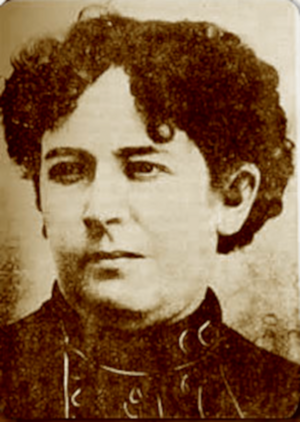Dolores Jiménez y Muro facts for kids
Quick facts for kids
Dolores Jiménez y Muro
|
|
|---|---|
 |
|
| Born | 7 June 1848 Aguascalientes, Aguascalientes, Mexico
|
| Died | 15 October 1925 (aged 75) Mexico City, Mexico
|
| Nationality | Mexican |
| Occupation | educator, revolutionary |
| Years active | 1911-1919 |
| Known for | Complot de Tacubaya |
Dolores Jiménez y Muro (born June 7, 1848 – died October 15, 1925) was a Mexican schoolteacher and a brave leader during the Mexican Revolution. She was born in Aguascalientes, Aguascalientes, Mexico. Dolores became well-known as a Socialist activist. She worked for big changes in society and was a strong supporter of General Emiliano Zapata.
Contents
Her Life Story
Dolores Jiménez y Muro was born on June 7, 1848, in Aguascalientes, Mexico. When she was young, her family moved to San Luis Potosí. Her family was quite well-off, and her father worked for the government.
Dolores grew up around many people with new and different ideas. She learned a lot at home instead of going to a formal school. She was very good at writing poems. In 1874, the government even asked her to read her poems at a special celebration. These poems were later put into a book called Un rayo de luz (A Ray of Light).
In 1883, Dolores lost both of her parents. She then started working as a teacher. This job helped her see how easily people could become poor or be treated unfairly.
Fighting for Change Before the Revolution
Dolores Jiménez started writing for newspapers like La Esmeralda and La Sombra de Zaragoza. By 1902, she was in charge of La Potosina Magazine. She kept teaching in country schools until 1904, when she moved to Mexico City.
In Mexico City, she wrote articles speaking out against the government of President Porfirio Díaz. Because of this, she was arrested. In prison, she met other strong women like Elisa Acuña Rossetti and Juana Belén Gutiérrez de Mendoza. From prison, these women began publishing a newspaper called Fiat Lux, which meant "Let there be light."
From 1905 to 1908, she worked for La Mujer Mexicana (Mexican Women). She also wrote for another newspaper called Diario del Hogar (Newspaper of the Home).
In 1907, Dolores, Elisa, and Juana started a group called "Daughters of Anahuac." This group had about 300 women who wanted better working conditions for women. They also supported workers going on strike. In 1908, Dolores helped start a workers' group in Mexico City called "Mexican Socialism." They kept publishing Fiat Lux as the voice of their group, the Mutual Society for Women.
In 1910, Dolores and others formed the "Anti-Reelectionist Women's Club: Daughters of Cuauhtémoc." This club, including members like Mercedes Arvides, organized a protest in Mexico City. They were protesting unfair elections. Because of these actions, Dolores and other women were arrested and sent to a fortress prison called San Juan de Ulúa.
Leading the Revolution
Even in prison in 1911, Dolores Jiménez stayed active in politics. She started a new publication called Regeneración y Concordia. Through this, she wanted to push for big changes in Mexico. She dreamed of a country with a better economy and fairer land distribution. She also wanted better lives for women and for the native people of Mexico. Regeneración y Concordia also focused on women's rights.
In March 1911, Francisco I. Madero called for protests in several states. Dolores helped organize these protests. She played a key role in the Complot de Tacubaya, a secret plan to remove President Porfirio Díaz and replace him with Francisco I. Madero.
Dolores is known for writing "The Political and Social Plan," which was published on March 18, 1911. This plan explained what the group wanted to achieve. It called for fair wages, affordable homes, better working conditions, and limits on foreign businesses in Mexico. It also suggested that schools should be managed and funded locally. Dolores also strongly believed that women should get higher wages, just like men. She also said that foreign companies in Mexico should hire at least half Mexican workers.
After her plan was read in Mexico City, Dolores was arrested again. Even though she was 61 years old, she was not released until she went on a hunger strike. She soon realized that Madero did not support the big changes she wanted. So, she decided to support Emiliano Zapata instead.
In 1913, she joined Zapata's forces. She helped write the introduction to the Plan de Ayala, which was Zapata's famous plan for land reform. She also ran a newspaper called La voz de Juárez. In this paper, she spoke out against Victoriano Huerta, who had taken power from Madero. Zapata even made her a brigadier general! However, Huerta ordered her imprisonment for eleven months in 1914. After her release, she rejoined Zapata and stayed with him until he was killed in 1919.
After the Revolution
Between 1921 and 1924, Dolores Jiménez worked for the Secretary of Education. She was part of a program that brought education and culture to different parts of Mexico.
She passed away on October 15, 1925, in Mexico City, at the age of 75.
Selected Writings
- Un rayo de luz (A Ray of Light)
- Al inmortal Hidalgo (To the Immortal Hidalgo)
- En el Aniversario (On the Anniversary)
- Crepúscuo (Twilight)
Images for kids
See also
 In Spanish: Dolores Jiménez y Muro para niños
In Spanish: Dolores Jiménez y Muro para niños


